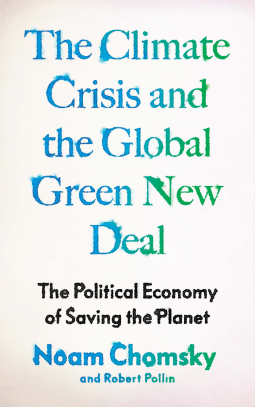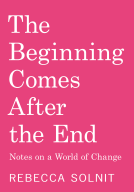
Climate Crisis and the Global Green New Deal
The Political Economy of Saving the Planet
by Noam Chomsky; Robert Pollin
This title was previously available on NetGalley and is now archived.
Send NetGalley books directly to your Kindle or Kindle app
1
To read on a Kindle or Kindle app, please add kindle@netgalley.com as an approved email address to receive files in your Amazon account. Click here for step-by-step instructions.
2
Also find your Kindle email address within your Amazon account, and enter it here.
Pub Date Sep 22 2020 | Archive Date Oct 01 2020
Verso Books (US) | Verso
Talking about this book? Use #TheClimateCrisisandtheGlobalGreenNewDeal #NetGalley. More hashtag tips!
Description
In this compelling new book, Noam Chomsky, the world’s leading public intellectual, and Robert Pollin, a renowned progressive economist, map out the catastrophic consequences of unchecked climate change—and present a realistic blueprint for change: the Green New Deal.
Together, Chomsky and Pollin show how the forecasts for a hotter planet strain the imagination: vast stretches of the Earth will become uninhabitable, plagued by extreme weather, drought, rising seas, and crop failure. Arguing against the misplaced fear of economic disaster and unemployment arising from the transition to a green economy, they show how this bogus concern encourages climate denialism.
Humanity must stop burning fossil fuels within the next thirty years and do so in a way that improves living standards and opportunities for working people. This is the goal of the Green New Deal and, as the authors make clear, it is entirely feasible. Climate change is an emergency that cannot be ignored. This book shows how it can be overcome both politically and economically.
Available Editions
| EDITION | Other Format |
| ISBN | 9781788739856 |
| PRICE | $18.95 (USD) |
| PAGES | 192 |
Average rating from 9 members
Featured Reviews
 David W, Media/Journalist
David W, Media/Journalist
If Noam Chomsky is willing to plunge into the Green New Deal (GND) debate, I am certainly willing to read it. Unfortunately, Chomsky’s comments are mostly the same as in his political criticism. He defers to experts for environmental issues. Robert Pollin is that expert, and the two of them answer questions about the Green New Deal from Chronis Polychroniou in Climate Crisis and Global Green New Deal. Sadly, the questions are softball lobs meant only to advance the narrative, and no three-way argument ever takes shape. The book never heats up beyond tepid on the GND.
Chomsky is no fan of Donald Trump. In one of his first answers, he diverts to Trump in language he normally saves for linguists who disagree with his theories of language acquisition or generative grammar, where he is, to put it mildly, biting. “The Chief is an infantile megalomaniac, and very effective conman, who couldn’t care less if the world burns or explodes, as long as he can pretend to be the winner as he two-steps over the cliff waving his little red hat triumphantly.” That sets the stage for Chomsky’s criticisms of the US government’s activities in things environmental.
Just one example: In 2018 the National Highway Traffic Safety Administration issued a 500 page environmental impact statement on vehicle emissions. It said that since temperatures will rise by more than four degrees Celsius anyway, the amount of emissions from vehicles will make no significant difference. “If one can find a comparable document of similar malevolence in the historical record, I would be interested in knowing about it.” Classic Chomsky. Classic Trump administration. But he is not nearly as sharp, informed or focused on the Green New Deal, and that’s what the book is supposed to be about.
Pollin is more on topic. In fact, the whole nub of the book is his analysis of how to pay for the Green New Deal. It appears halfway through, and he is able to show it is most doable. If there is the political will.
The four funding sources are:
1, A carbon tax in which 75% of the proceeds are rebated to the public, and 25% into clean energy projects.
2. A transfer of funds out of the military budgets globally
3. A Green Bond lending program from the US Federal Reserve and the European Central Bank
4. The end of all fossil fuel subsidies, with 25% of amount channeled into clean energy projects.
Pollin backs them up with stats. In 2019 Credit Suisse calculated the total value of global financial assets at $317 trillion. The Green New Deal requires $2.4 trillion a year (at first). This is just 7/10 of one percent of those financial assets. He says the $1.3 trillion from public contribution net investment is all of 2.5% of GDP. That would allow the world to reach zero emissions by 2050, without breaking the bank. He does this for all four sources. Getting governments to agree however, is out of scope.
Sadly, rather reducing the 33 billion tons of carbon dumped into the ecosphere annually, we are still increasing. We’re now looking at 38 billion tons a year. With perhaps a temporary dip from the coronavirus pandemic.
In other words, there is no political will to accomplish anything at all. All of the Paris COP21 nations have failed to live up to their commitments. What is needed is a Franklin Delano Roosevelt to implement the New Deal by directing the entire government to focus on it. FDR mobilized the country to climb out of the Depression and then again to produce everything needed to win World War II. Both Chomsky and Pollin consider the ecological disaster to be an emergency of at least the same magnitude as the ones FDR faced. Like his program, the Green New Deal will create jobs and increase wealth – just not in fossil fuels. But short of an FDR in charge, this book shows no path to avoid oblivion at all.
If all it is is the four funding sources, this would have been better much received as a magazine article. It is not enough for a book.
David Wineberg
Readers who liked this book also liked:
Jakub Politzer (Illustrator), Christina Dumalasova (adapter), Katerina Horakova (adapter)
Comics, Graphic Novels, Manga, General Fiction (Adult)
We Are Bookish
Mystery & Thrillers, OwnVoices, Teens & YA
Allison Holker
Biographies & Memoirs, Health, Mind & Body, Parenting, Families, Relationships
Kotteri
Comics, Graphic Novels, Manga, General Fiction (Adult), Teens & YA













